2016 VAUXHALL MOVANO_B suspension
[x] Cancel search: suspensionPage 186 of 233
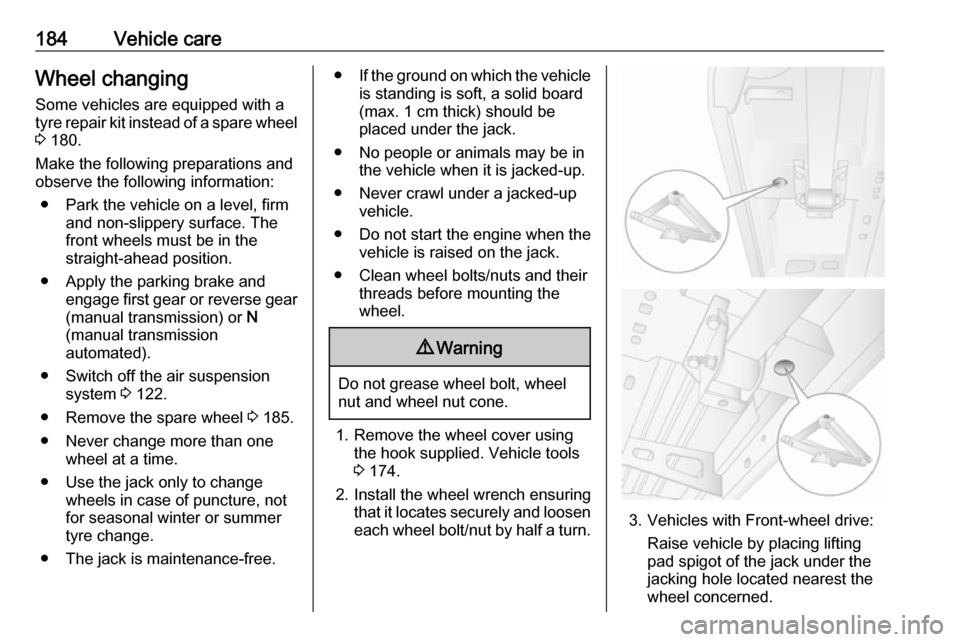
184Vehicle careWheel changingSome vehicles are equipped with a
tyre repair kit instead of a spare wheel
3 180.
Make the following preparations and
observe the following information:
● Park the vehicle on a level, firm and non-slippery surface. The
front wheels must be in the
straight-ahead position.
● Apply the parking brake and engage first gear or reverse gear
(manual transmission) or N
(manual transmission
automated).
● Switch off the air suspension system 3 122.
● Remove the spare wheel 3 185.
● Never change more than one wheel at a time.
● Use the jack only to change wheels in case of puncture, not
for seasonal winter or summer
tyre change.
● The jack is maintenance-free.● If the ground on which the vehicle
is standing is soft, a solid board
(max. 1 cm thick) should be
placed under the jack.
● No people or animals may be in the vehicle when it is jacked-up.
● Never crawl under a jacked-up vehicle.
● Do not start the engine when the vehicle is raised on the jack.
● Clean wheel bolts/nuts and their threads before mounting thewheel.9 Warning
Do not grease wheel bolt, wheel
nut and wheel nut cone.
1. Remove the wheel cover using the hook supplied. Vehicle tools
3 174.
2. Install the wheel wrench ensuring that it locates securely and loosen
each wheel bolt/nut by half a turn.
3. Vehicles with Front-wheel drive:
Raise vehicle by placing lifting
pad spigot of the jack under the
jacking hole located nearest the
wheel concerned.
Page 190 of 233
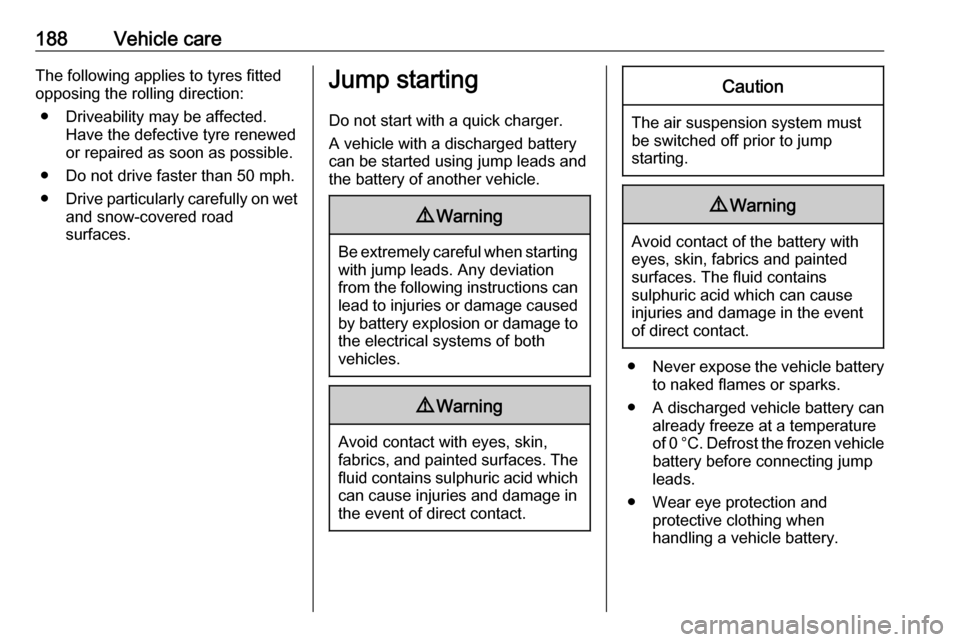
188Vehicle careThe following applies to tyres fitted
opposing the rolling direction:
● Driveability may be affected. Have the defective tyre renewed
or repaired as soon as possible.
● Do not drive faster than 50 mph.
● Drive particularly carefully on wet
and snow-covered road
surfaces.Jump starting
Do not start with a quick charger.
A vehicle with a discharged battery
can be started using jump leads and
the battery of another vehicle.9 Warning
Be extremely careful when starting
with jump leads. Any deviation
from the following instructions can
lead to injuries or damage caused
by battery explosion or damage to the electrical systems of both
vehicles.
9 Warning
Avoid contact with eyes, skin,
fabrics, and painted surfaces. The fluid contains sulphuric acid which can cause injuries and damage in
the event of direct contact.
Caution
The air suspension system must
be switched off prior to jump
starting.
9 Warning
Avoid contact of the battery with
eyes, skin, fabrics and painted
surfaces. The fluid contains
sulphuric acid which can cause
injuries and damage in the event
of direct contact.
● Never expose the vehicle battery
to naked flames or sparks.
● A discharged vehicle battery can already freeze at a temperature
of 0 °C. Defrost the frozen vehicle
battery before connecting jump leads.
● Wear eye protection and protective clothing when
handling a vehicle battery.
Page 191 of 233
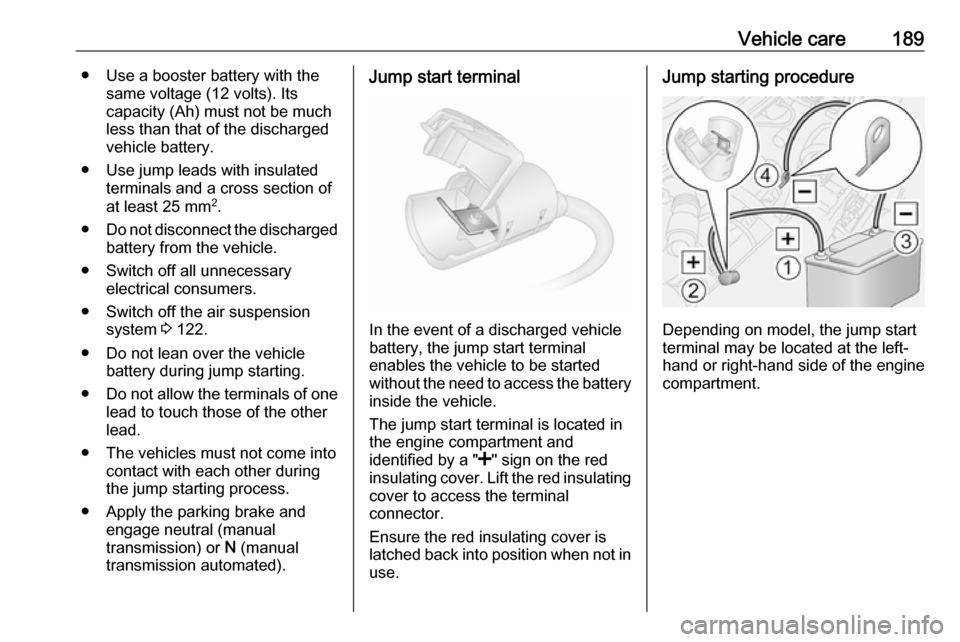
Vehicle care189● Use a booster battery with thesame voltage (12 volts). Its
capacity (Ah) must not be much less than that of the discharged
vehicle battery.
● Use jump leads with insulated terminals and a cross section of
at least 25 mm 2
.
● Do not disconnect the discharged
battery from the vehicle.
● Switch off all unnecessary electrical consumers.
● Switch off the air suspension system 3 122.
● Do not lean over the vehicle battery during jump starting.
● Do not allow the terminals of one
lead to touch those of the other
lead.
● The vehicles must not come into contact with each other during
the jump starting process.
● Apply the parking brake and engage neutral (manual
transmission) or N (manual
transmission automated).Jump start terminal
In the event of a discharged vehicle
battery, the jump start terminal
enables the vehicle to be started
without the need to access the battery inside the vehicle.
The jump start terminal is located in
the engine compartment and
identified by a " <" sign on the red
insulating cover. Lift the red insulating
cover to access the terminal
connector.
Ensure the red insulating cover is
latched back into position when not in
use.
Jump starting procedure
Depending on model, the jump start
terminal may be located at the left-
hand or right-hand side of the engine
compartment.
Page 192 of 233
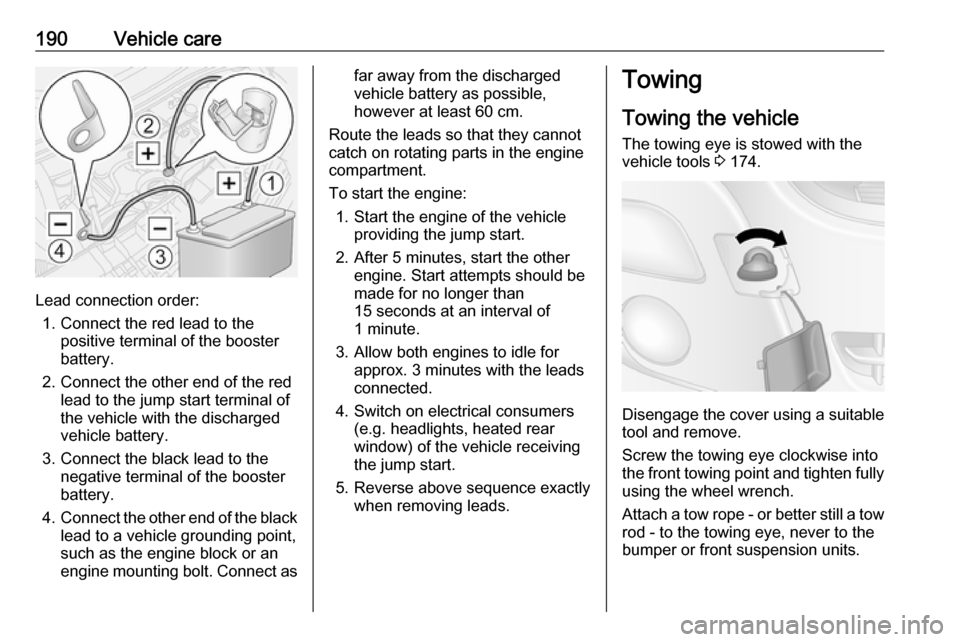
190Vehicle care
Lead connection order:1. Connect the red lead to the positive terminal of the booster
battery.
2. Connect the other end of the red lead to the jump start terminal of
the vehicle with the discharged
vehicle battery.
3. Connect the black lead to the negative terminal of the booster
battery.
4. Connect the other end of the black
lead to a vehicle grounding point,
such as the engine block or an
engine mounting bolt. Connect as
far away from the discharged
vehicle battery as possible,
however at least 60 cm.
Route the leads so that they cannot
catch on rotating parts in the engine
compartment.
To start the engine: 1. Start the engine of the vehicle providing the jump start.
2. After 5 minutes, start the other engine. Start attempts should be
made for no longer than
15 seconds at an interval of
1 minute.
3. Allow both engines to idle for approx. 3 minutes with the leads
connected.
4. Switch on electrical consumers (e.g. headlights, heated rear
window) of the vehicle receiving
the jump start.
5. Reverse above sequence exactly when removing leads.Towing
Towing the vehicle
The towing eye is stowed with the vehicle tools 3 174.
Disengage the cover using a suitable
tool and remove.
Screw the towing eye clockwise into
the front towing point and tighten fully using the wheel wrench.
Attach a tow rope - or better still a tow
rod - to the towing eye, never to the
bumper or front suspension units.
Page 193 of 233
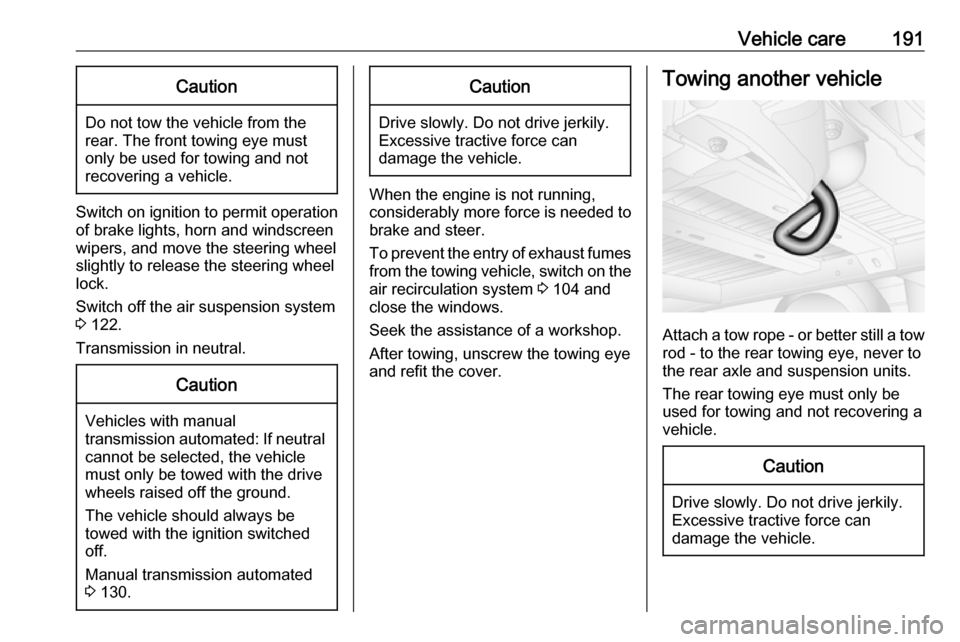
Vehicle care191Caution
Do not tow the vehicle from the
rear. The front towing eye must
only be used for towing and not
recovering a vehicle.
Switch on ignition to permit operation
of brake lights, horn and windscreen
wipers, and move the steering wheel
slightly to release the steering wheel
lock.
Switch off the air suspension system 3 122.
Transmission in neutral.
Caution
Vehicles with manual
transmission automated: If neutral cannot be selected, the vehiclemust only be towed with the drive
wheels raised off the ground.
The vehicle should always be
towed with the ignition switched
off.
Manual transmission automated
3 130.
Caution
Drive slowly. Do not drive jerkily.
Excessive tractive force can
damage the vehicle.
When the engine is not running,
considerably more force is needed to
brake and steer.
To prevent the entry of exhaust fumes
from the towing vehicle, switch on the
air recirculation system 3 104 and
close the windows.
Seek the assistance of a workshop.
After towing, unscrew the towing eye
and refit the cover.
Towing another vehicle
Attach a tow rope - or better still a tow
rod - to the rear towing eye, never to
the rear axle and suspension units.
The rear towing eye must only be
used for towing and not recovering a
vehicle.
Caution
Drive slowly. Do not drive jerkily.
Excessive tractive force can
damage the vehicle.
Page 226 of 233

224IndexAAccessories and vehicle modifications .......................... 154
Adaptive forward lighting .....98, 164
AdBlue .......................... 87, 125, 196
Adblue gauge ............................... 79
AdBlue tank ................................ 218
Adjustable air vents ...................113
Airbag and belt tensioners ...........84
Airbag deactivation ................53, 84
Airbag label................................... 49 Airbag system .............................. 49
Air conditioning regular operation ................................ 114
Air conditioning system .............. 104
Air intake .................................... 114
Air suspension ........................... 122
Air suspension system................ 190
Air vents...................................... 113
Antifreeze ................................... 157
Antilock brake system ................ 134
Antilock brake system (ABS) .......86
Anti-theft alarm system ................31
Anti-theft bolts............................. 184
Anti-theft locking system .............. 30
Anti-theft security lock ..................21
Appearance care ........................192
Armrest ........................................ 44
Ashtrays ....................................... 77
Automatic light control .................95Automatic locking ...................21, 25
Autostop ..................................... 118
Auxiliary heater ........................... 109
B Battery discharge protection ......102
Battery, jump starting.................. 188
Belts.............................................. 46 BlueInjection ............................... 125
Bonnet ....................................... 155
Brake assist ............................... 136
Brake fluid .......................... 159, 196
Brakes ............................... 134, 159
Brake system ............................... 85
Breakdown.................................. 190
Bulb replacement ....................... 162
C Capacities .................................. 218
Cargo management system ........67
Car Pass ...................................... 19
Catalytic converter .....................124
Central locking system ................21
Centre high-mounted brake light 167
Changing tyre and wheel size ...179
Charging system .......................... 84
Child locks ................................... 25
Child restraint installation locations ................................... 56
Child restraints.............................. 55
Child restraint systems ................55
Page 230 of 233

228Steering...................................... 116
Steering column controls ..............73
Steering wheel adjustment ......9, 73
Steering wheel controls ...............73
Stop engine .................................. 85
Stop-start system............ 16, 88, 119
Storage ......................................... 64
Storage compartments .................64
Sunglasses storage .....................65
Sun visors .................................... 37
Suspension height ......................122
Suspension seat ........................... 40
Symbols ......................................... 4
T
Tachograph ............................ 89, 94
Tachometer ................................. 78
Tail lights ................................... 166
Technical data ............................ 201
Three-point seat belt .................... 47
Tools .......................................... 174
Top-tether fastening eyes ............63
Tow bar....................................... 150
Towing ........................................ 150
Towing another vehicle .............191
Towing a trailer ........................... 150
Towing equipment .....................151
Towing eye ................................. 190
Towing the vehicle .....................190
Traction Control system ............. 136Trailer coupling ........................... 150
Trailer stability assist .................151
Trailer towing ............................. 150
Transmission ............................... 16
Transmission display ...........81, 130
Tread depth ............................... 179
Trip computer .............................. 92
Triple-Info-Display .......................90
Trip odometer .............................. 78
Turbo engine warm-up ...............118
Turn and lane-change signals .....98
Turn signal ................................... 83
Tyre chains ................................ 180
Tyre changing ............................. 184
Tyre designations ......................176
Tyre pressure ............................ 176
Tyre pressure monitoring system ............................... 87, 177
Tyre pressures ........................... 219
Tyre repair kit ............................. 180
Tyres .......................................... 175
Tyres and wheel size, changing. 179
U Ultrasonic parking assist............. 142
Underseat storage .......................66
Upholstery .................................. 193
Upshift .......................................... 86
Using this manual ..........................3V
Vehicle battery ........................... 159
Vehicle checks............................ 155
Vehicle data ................................ 200
Vehicle data recording and privacy ..................................... 221
Vehicle dimensions .................... 209
Vehicle Identification Number ....198
Vehicle jack ................................ 174
Vehicle messages .......................90
Vehicle security ............................ 30
Vehicle specific data ......................3
Vehicle storage ........................... 154
Vehicle tools ............................... 174
Vehicle unlocking ........................... 6
Vehicle weight ........................... 202
Ventilation ................................... 103
W
Warning chimes ........................... 91
Warning lights ............................... 77
Warning triangle .......................... 69
Washer and wiper systems .........14
Washer fluid ............................... 159
Washing the vehicle ...................192
Wheel changing .........................184
Wheel covers ............................. 180
Wheels and tyres .......................175
Wheel wrench ............................. 174
Wide view mirror .....................34, 37